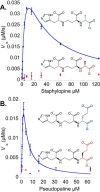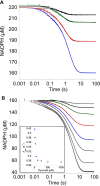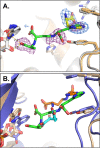Staphylopine and pseudopaline dehydrogenase from bacterial pathogens catalyze reversible reactions and produce stereospecific metallophores
- PMID: 31615895
- PMCID: PMC6879343
- DOI: 10.1074/jbc.RA119.011059
Staphylopine and pseudopaline dehydrogenase from bacterial pathogens catalyze reversible reactions and produce stereospecific metallophores
Abstract
Pseudopaline and staphylopine are opine metallophores biosynthesized by Pseudomonas aeruginosa and Staphylococcus aureus, respectively. The final step in opine metallophore biosynthesis is the condensation of the product of a nicotianamine (NA) synthase reaction (i.e. l-HisNA for pseudopaline and d-HisNA for staphylopine) with an α-keto acid (α-ketoglutarate for pseudopaline and pyruvate for staphylopine), which is performed by an opine dehydrogenase. We hypothesized that the opine dehydrogenase reaction would be reversible only for the opine metallophore product with (R)-stereochemistry at carbon C2 of the α-keto acid (prochiral prior to catalysis). A kinetic analysis using stopped-flow spectrometry with (R)- or (S)-staphylopine and kinetic and structural analysis with (R)- and (S)-pseudopaline confirmed catalysis in the reverse direction for only (R)-staphylopine and (R)-pseudopaline, verifying the stereochemistry of these two opine metallophores. Structural analysis at 1.57-1.85 Å resolution captured the hydrolysis of (R)-pseudopaline and allowed identification of a binding pocket for the l-histidine moiety of pseudopaline formed through a repositioning of Phe-340 and Tyr-289 during the catalytic cycle. Transient-state kinetic analysis revealed an ordered release of NADP+ followed by staphylopine, with staphylopine release being the rate-limiting step in catalysis. Knowledge of the stereochemistry for opine metallophores has implications for future studies involving kinetic analysis, as well as opine metallophore transport, metal coordination, and the generation of chiral amines for pharmaceutical development.
Keywords: Pseudomonas aeruginosa (P. aeruginosa); Staphylococcus aureus (S. aureus); crystal structure; dehydrogenase; kinetics; metallophore; opine; pseudopaline; siderophore; staphylopine.
© 2019 McFarlane et al.
Conflict of interest statement
The authors declare that they have no conflicts of interest with the contents of this article
Figures









References
-
- Ghssein G., Brutesco C., Ouerdane L., Fojcik C., Izaute A., Wang S., Hajjar C., Lobinski R., Lemaire D., Richaud P., Voulhoux R., Espaillat A., Cava F., Pignol D., Borezée-Durant E., and Arnoux P. (2016) Biosynthesis of a broad-spectrum nicotianamine-like metallophore in Staphylococcus aureus. Science 352, 1105–1109 10.1126/science.aaf1018 - DOI - PubMed
-
- Lhospice S., Gomez N. O., Ouerdane L., Brutesco C., Ghssein G., Hajjar C., Liratni A., Wang S., Richaud P., Bleves S., Ball G., Borezée-Durant E., Lobinski R., Pignol D., Arnoux P., and Voulhoux R. (2017) Pseudomonas aeruginosa zinc uptake in chelating environment is primarily mediated by the metallophore pseudopaline. Sci. Rep. 7, 1–10 10.1038/s41598-017-16765-9 - DOI - PMC - PubMed
-
- Mastropasqua M. C., D'Orazio M., Cerasi M., Pacello F., Gismondi A., Canini A., Canuti L., Consalvo A., Ciavardelli D., Chirullo B., Pasquali P., and Battistoni A. (2017) Growth of Pseudomonas aeruginosa in zinc poor environments is promoted by a nicotianamine-related metallophore. Mol. Microbiol. 106, 543–561 10.1111/mmi.13834 - DOI - PubMed
Publication types
MeSH terms
Substances
Associated data
- Actions
- Actions
- Actions
- Actions
- Actions
- Actions
- Actions
- Actions
- Actions
Grants and funding
LinkOut - more resources
Full Text Sources
Miscellaneous

